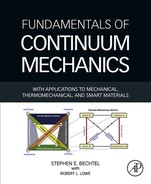The Physical Basis of Constitutive Assumptions
It is essential to produce a physically meaningful list of arguments for the constitutive functions that characterize a particular material. In the thermomechanical theory (refer to Section 5.3), constitutive functions must be given for the Cauchy stress T, Helmholtz free energy ψ, heat flux vector q, and entropy η, which depend in some manner on the motion χ and temperature Θ, and possibly their rates, gradients, and histories. Why do we assume that for a thermoelastic material (see Chapter 6), the response functions ![]() ,
, ![]() ,
, ![]() , and
, and ![]() , evaluated at position x and time t, depend on χ and Θ through the list F = Grad χ, Θ, and g = grad Θ, also evaluated at position x and time t? Why, for instance, do we not also include in the list
, evaluated at position x and time t, depend on χ and Θ through the list F = Grad χ, Θ, and g = grad Θ, also evaluated at position x and time t? Why, for instance, do we not also include in the list
(b) ![]() ,
,
(c) L = grad v,
(d) F evaluated at a position y ≠ x and time t,
(e) Θ evaluated at time t + 5 seconds, or
(f) Θ evaluated at time t − 5 seconds?
Some of these terms are excluded from the list of arguments through two postulates on material behavior [64]:
(1) Axiom of determinism: The response of a body is determined by the history of motion and temperature for that body. Therefore, the response functions for T, q, ψ, and η at time t can depend only on functions of x and Θ evaluated at past or present times τ ≤ t. Thus, the term “Θ evaluated at time t + 5 seconds” cannot be included in the list of arguments.
(2) Axiom of neighborhood: The response of a given particle Y of the body does not depend on the motion and temperature of particles outside a small neighborhood of Y in any configuration. Stated differently, the motion and temperature of particles a finite distance from Y in a particular configuration are disregarded in calculating the response of Y. (By the smoothness assumption made on the motion of the body, a particle a finite distance from Y in one configuration is a finite distance from Y in all configurations.) Because of this assumption, the term “F evaluated at a position y ≠ x and time t” cannot be included in the list of arguments, unless y is arbitrarily close to x.
It is also common to assume that the argument list contains gradients of motion and temperature up to and including only first order. Materials satisfying this assumption are called simple [64]. In other words, a simple material is one whose constitutive functions are completely determined by the material's response to homogeneous deformations (i.e., deformations for which F = F(t) only). Hence, the response functions for a simple material cannot depend on the term “Grad(Grad χ)” or the term “grad(grad Θ).”
Lastly, the response of a thermoelastic material does not depend on the history or rate of the deformation or temperature. Thus, the terms “L = grad v” and “Θ evaluated at time t − 5 seconds” cannot be included in the list of arguments. (Recall that the velocity gradient L is related to the rate of deformation ![]() through
through ![]() .)
.)
